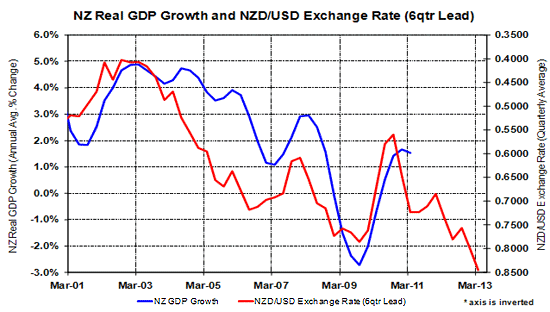
 By Roger J Kerr
By Roger J Kerr
It is unlikely that both NZ short-term and long-term interest rates will move any lower from the current levels (one year swaps at 3.25% and 10 years at 4.85%).
However when and how fast they move upwards is the debate that is exercising the minds of borrowers and investors alike.
If you are a true believer in the 'global double-dip recession' scenario you might see rates lower from here, but I am ruling that out as an even low-probability scenario.
Alan Bollard will be returning from the Jackson Hole central banker’s pow-wow with lower global growth and NZ currency/export commodity price divergence on his mind.
Both factors suggest lower GDP growth for us in 2012 and thus lower inflationary risks - that is, interest rates at the current low levels for longer.
It would be very unwise for Alan to look backwards at the stronger than anticipated - except by us - domestic economic data over the last nine months and conclude that he should keep the same upbeat tone in the 15 September Monetary Policy Statement (MPS) as what he had in the June statement. The RBNZ MPS statement on 15 September has the capability to be considerably more dovish on the economic outlook than what the market anticipates.
Many economists fail to comprehend the dominant impact the NZD/USD exchange rate has on GDP growth in New Zealand.
Let’s hope the RBNZ economists don’t miss this connection.
As we have seen from business lobby groups like the Winegrowers Association recently, the prolonged strength of the NZD above 0.8000 is doing a lot of damage to exporter profits, investment and jobs. Based on historical relationships the Kiwi dollar above 0.8000 suggests annual GDP growth will head back to negative over the next 18 months (see chart). The outlook for the NZ economy has changed dramatically over recent weeks with the currency and export prices diverging.

The other matter that will be weighing on Alan’s mind as he drafts the MPS is the sharp increase in bank credit margins as a result of recent turmoil in global financial and investment markets.
European banks are under capital pressure and their credit standing is deteriorating. Australasian banks borrow part of their funding requirements from European debt capital markets and investors in those markets are demanding much higher credit premiums. Increased cost of funds for the banks (from both offshore and onshore retail sources) adds to the equation to leave the OCR lower for longer (at this stage).
Given this outlook for interest rates, Mum and Dad retail investors should swamp the current Air New Zealand $150 million corporate bond offering. In normal market conditions an airline with a Moody’s Baa3 credit rating (equivalent to S & P rating of BBB-) on credit outlook 'negative' would have to pay 250 to 275 basis points (2.50% to 2.75%) over the five-year swap rate. However, do not be surprised to see Air New Zealand issue their bonds at 200 points over swap rates for an all-up interest rate of 6.20% - such is the pent-up retail investor demand for a restricted supply of corporate bonds to invest into.
No chart with that title exists.
--------------------
* Roger J Kerr runs Asia Pacific Risk Management. He specialises in fixed interest securities and is a commentator on economics and markets. More commentary and useful information on fixed interest investing can be found at rogeradvice.com

We welcome your comments below. If you are not already registered, please register to comment
Remember we welcome robust, respectful and insightful debate. We don't welcome abusive or defamatory comments and will de-register those repeatedly making such comments. Our current comment policy is here.